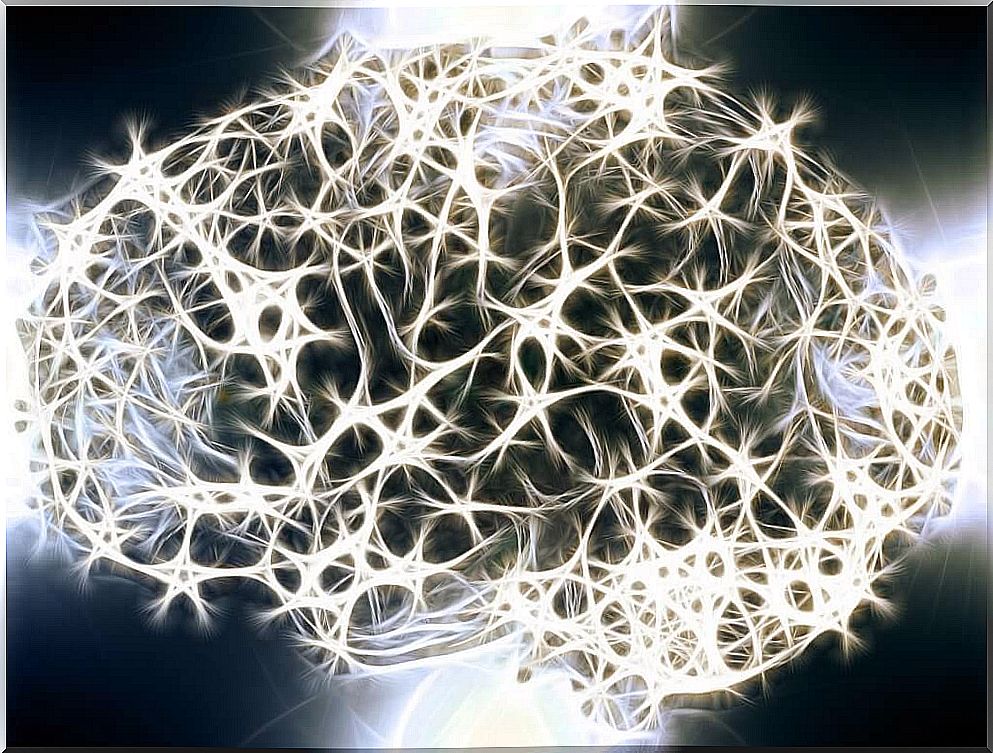White Substance Of The Nervous System: Why Is It So Important?

The white matter has the task of transmitting information throughout the central nervous system. The name derives from the white color of the myelin sheath, which surrounds the axons of neurons and allows the electrical impulse to pass from one neuron to another.
The white matter in the brain is found under the cortex made up of gray matter, while in the spinal cord it is outside the gray matter. It is made up of axons that send sensory and motor information. However, it is also involved in other processes, not just in sending information.
Localization of white matter in the central nervous system
The white matter of the two cerebral hemispheres is made up of three types of fibers:
- Interhemispheric commissural formations : they are the fibers that unite the two cerebral hemispheres. Within this category is the anterior commissure, which joins the olfactory bulbs to the temporal lobe. The corpus callosum joins the right hemisphere to the left one; if this part is dissected, much of the communication between the two hemispheres is interrupted.
- Projection fibers : these are axons that reach the cerebral cortex and are organized in such a way as to irradiate the two cerebral hemispheres.
- Association fibers : these are the axons that unite different areas of the cerebral cortex of the same hemisphere
The spinal cord is the most abundant portion of the central nervous system and is in constant relationship with the peripheral nervous system; has great importance in terms of sensory and motor functions. The spinal cord is protected by the spinal column, which absorbs blows to avoid possible injuries. In the spinal cord the white matter is on the outside, covering the gray matter, and is organized in three columns: dorsal, lateral and ventral.
- The dorsal white column is made up of somatic afferent fibers of the spinal nerves that run through the spinal cord without creating synapses. They are grouped in two files, cuneato and frail. The former specifically collects afferents from the upper thoracic and cervical segments of the spinal cord. The second, on the other hand, brings together the afferents coming from the sacral, lumbar and lower thoracic segments.
- The ventral and lateral white column is made up of ascending nerve pathways, which carry somatic and visceral information, and descending pathways, which send somatic and sensory modulation information.
The relationship with cognitive functions
White matter has always been associated with processing speed, but in recent years it has been discovered that there is probably a relationship with different cognitive functions, given the impact on these functions of its possible deterioration. There are many studies that have attempted to clarify the role of white matter in language, memory or attention.
For example, less volume in the right frontal white matter appears to be related to the degree of sustained attention alteration in children with attention disorder. In patients with Alzheimer’s and mild cognitive impairment there was a significant link between white matter volume and memory, and degeneration may also depend on that of gray matter.

Disconnection of the fibers that connect the thalamus to the frontal cortex can interfere with verbal memory and impair working memory. On the other hand, learning and visual memory are related to parietal and temporal white matter. The correlation between working memory and temporal, parietal and frontal white matter areas is documented by several studies.
Diffuse axonal damage
Diffuse axonal damage is the result of a traumatic injury with acceleration-deceleration or rotation mechanisms. It is one of the most frequent causes of morbidity in patients with TBI, usually following car accidents. It consists of several focal lesions in the white matter from 1 to 15 mm in a characteristic distribution.
It triggers an immediate loss of consciousness; more than 90% of patients remain in a vegetative state. Diffuse axonal damage does not cause death, as the brain stem continues to function and take care of the body’s vital functions. It is responsible for most of the alterations in attention, memory, processing speed, and executive alterations in patients with moderate or severe head injuries.

The mechanical component of the trauma produces stretching, twisting and rupture of the axons and capillaries of the brain, causing microhemorrhages. Due to the interruption of the ascending fibers, from the clinical point of view, confusion, loss of consciousness or coma occur depending on the severity. The degree of disconnection determines the severity and duration of the coma and the presence and duration of post-traumatic amnesia.
At the neuropsychological level, diffuse axonal damage impairs the ability to learn and learn and causes alterations in attention, information processing speed and executive functions. The alteration of the frontal functions is a constant and this is because these functions require the integrity of all the cortico-cortical and cortico-subcortical circuits involved.
Pathologies that cause the degeneration of the white matter
Various pathologies cause deterioration of the white matter with serious consequences at the cognitive, motor and sensory levels. One of these is Binswanger’s disease . In this case, the external brain aspect is normal, but the gray matter / white matter ratio is very low.
Binswanger’s disease ranges from axon damage to axon demyelination. Common symptoms are slowing of thinking ability, memory changes, confusion, apathy and loss of interest in the external environment. Motor slowing or instability are early symptoms of the disease.

Leukodystrophies are one of the diseases that affect the white matter. These are rare genetic diseases that cause an alteration in the metabolism of myelin. The most common clinical manifestations are quadriplegia, ataxia, blindness, deafness and cognitive impairment. They are degenerative diseases and the first symptoms appear already in childhood.
As you have read in this article, white matter is a fundamental part of the nervous system. It is the common thread for the information that our brain receives, but it is also a communication channel that the brain uses to give orders to different organs. A good amount of white matter, and above all a white matter in excellent condition, favors above all the attention and the speed with which we perform the different cognitive processes, such as decision making or the acquisition of new knowledge.
Bibliography
Kandel, ER et al. (2014), Principles of neuroscience , Milan: Ambrosiana Publishing House.
Santoro, G. & Lanza, PL (2003), Diffuse axonal injury (DAI) : http://journals.sagepub.com/doi/abs/10.1177/19714009030160S143?journalCode=neua
Wasserman J. and Koenigsberg RA (2007), Diffuse axonal injury : http://emedicine.medscape.com/article/339912-overview









